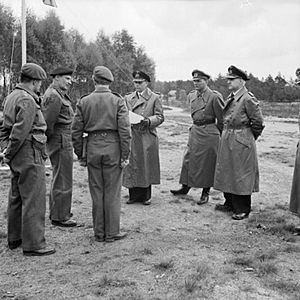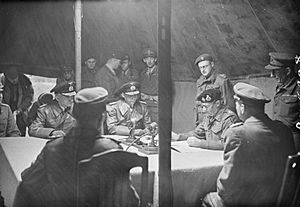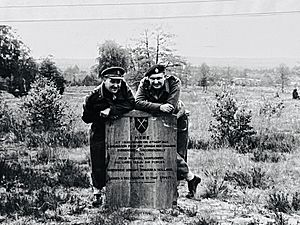German surrender at Lüneburg Heath facts for kids

On May 4, 1945, at 6:30 PM, an important event happened at Lüneburg Heath in Germany. Field Marshal Sir Bernard Law Montgomery accepted the complete surrender of German forces. This included all German troops in the Netherlands, northwest Germany (and its islands), and Denmark. It also covered all German naval ships in these areas. This surrender took place just before World War II officially ended in Europe. The agreement was signed inside a tent on Timeloberg hill, where Montgomery had set up his headquarters.
Contents
Germany's Surrender in 1945

British forces took control of Lüneburg on April 18, 1945. Field Marshal Montgomery then made a villa in Häcklingen his main base. On May 3, a group of German officers arrived at his temporary headquarters on Timeloberg hill. They were sent by Großadmiral Karl Dönitz. He had been named the new leader of Germany and head of its armed forces by Adolf Hitler.
Dönitz knew about the areas the Allies planned to occupy in Germany. He hoped that by negotiating surrenders bit by bit, he could gain time. This would allow German soldiers and people fleeing from the east to escape the Red Army (Soviet forces). He also wanted to keep a safe area open west of the River Elbe.
Dönitz felt it was not proper for him, as the new head of state, to negotiate directly with a field marshal. So, he sent a delegation led by Admiral Hans-Georg von Friedeburg, the new head of the German navy. Montgomery refused their first offer to surrender only one army group. He demanded a complete surrender of all German forces on his northern and western sides. The German officers said they didn't have the power to agree to this. However, they promised to go back and get permission from Dönitz.
How the Surrender Happened
The German officers returned the next day, May 4, at 6:00 PM. This time, they brought another officer, Colonel Fritz Poleck, who represented the Oberkommando der Wehrmacht (the German armed forces high command). Admiral von Friedeburg was taken to Montgomery's command caravan to confirm they were ready to sign.
For the signing ceremony, Montgomery sat at the head of a table covered with an army blanket. Two BBC microphones were in front of him. He called each German delegate to sign the surrender document at 6:30 PM. The British Pathé News filmed the ceremony. The BBC also recorded it for radio, with a reporter named Chester Wilmot giving commentary. One of Montgomery's senior intelligence officers, Colonel James Oliver Ewart, made sure all documents were translated and conversations understood correctly.
Who Signed the Agreement?
The important people who signed the surrender agreement were:
- For the United Kingdom:
- Field Marshal Bernard Montgomery – He was the commander of the 21st Army Group.
- For Germany:
- Admiral Hans-Georg von Friedeburg – He was the Commander-in-Chief of the German Navy (Kriegsmarine).
- General Eberhard Kinzel – He was the chief of staff for the northwest German army (Heer).
- Rear Admiral Gerhard Wagner – He was in charge of the operations department for the Kriegsmarine.
- Colonel Fritz Poleck – He represented the Oberkommando der Wehrmacht (the German armed forces high command).
- Major Hans Jochen Freidel – He was a staff officer working for General Kinzel.
What Happened Next?
Admiral von Friedeburg later signed the main German Instrument of Surrender on May 7 in Reims, France. This document officially ended World War II in Europe. He signed it again on May 8 in Berlin with representatives from the Soviet, French, and US forces.
After the war, the British put up a monument on what they called Victory Hill. This monument was later moved to the Royal Military Academy Sandhurst in 1958. Today, the original spot is part of a military area and cannot be visited by the public. In 1995, a new monument was placed on the edge of the Timeloberg, outside the restricted area. The last person alive who was part of these negotiations was one of Montgomery's interpreters, Derek Knee. He passed away in 2014 at the age of 91.
See also
- Debellatio
- End of World War II in Europe
- German Instrument of Surrender



